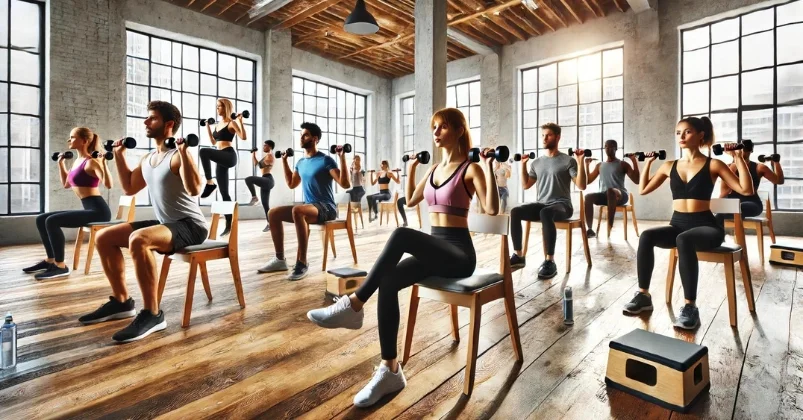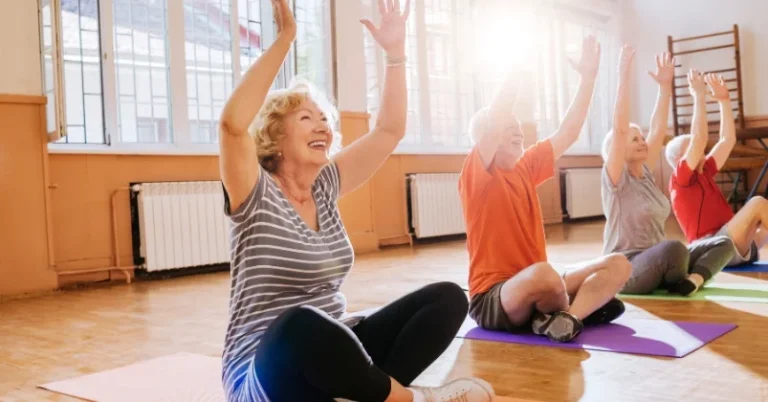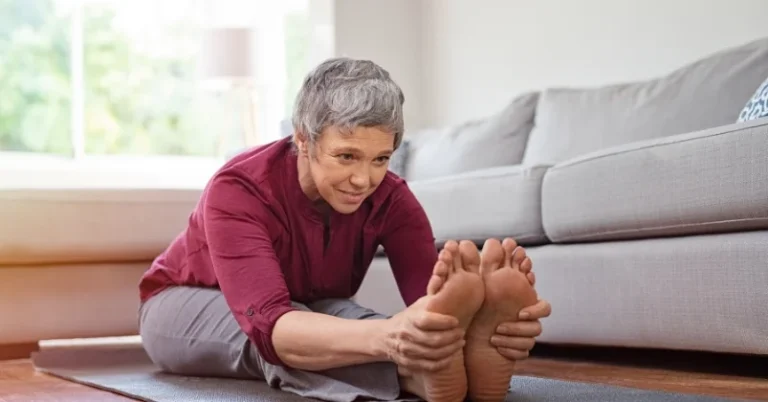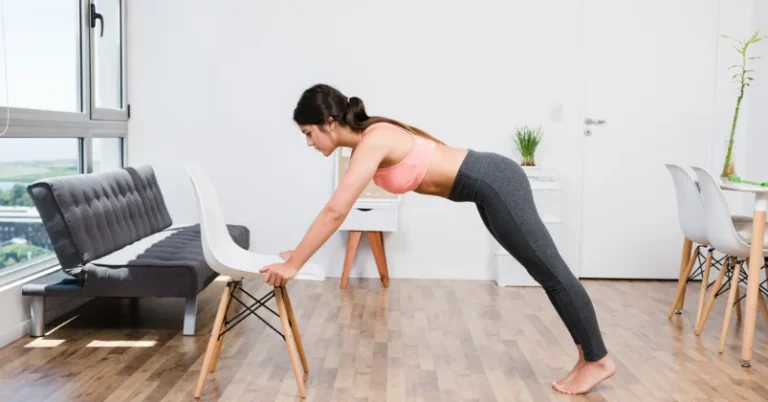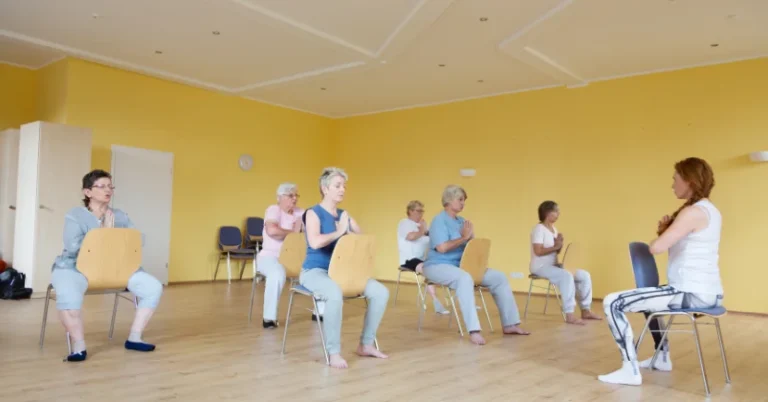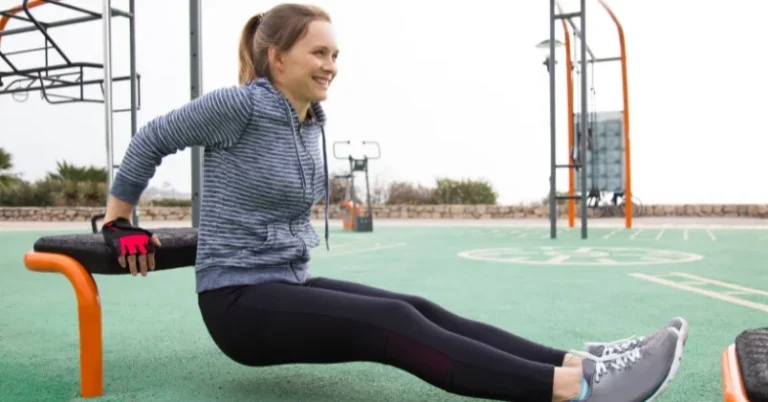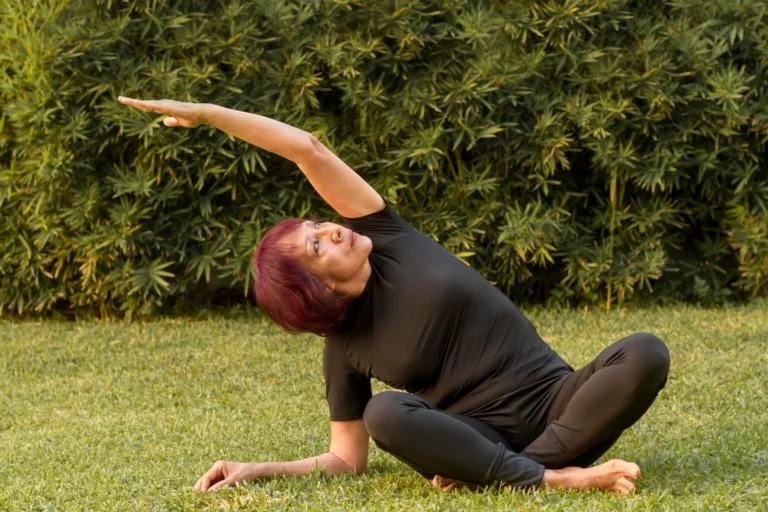Best chair Exercises To Lose Weight
In the vast realm of fitness, amid the cacophony of heavy gym machinery and the fierce routines of high-intensity workouts, there emerges a quiet yet powerful contender: chair exercises.
At first glance, one might wonder how something as simple and ubiquitous as a chair could play a pivotal role in an effective weight loss journey.
Yet, the beauty of chair exercises lies not just in their simplicity, but in their profound ability to offer an accessible gateway to fitness for everyone, regardless of age, fitness level, or mobility.
The Transformative Power of Chair Exercises
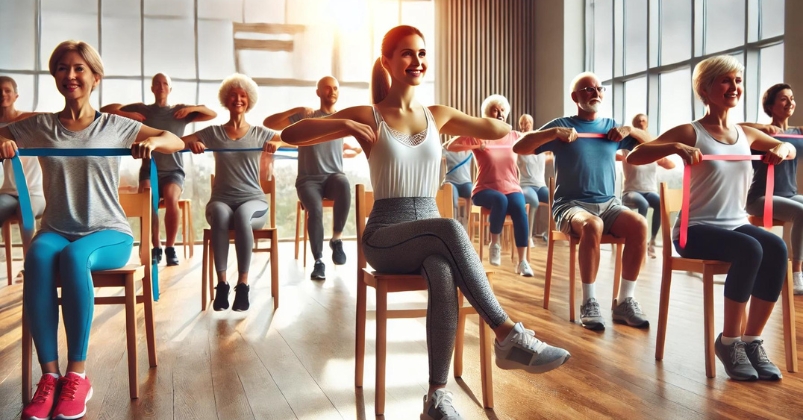
The concept of chair exercises is not merely about the convenience of a chair but about a paradigm shift in understanding exercise. It's about recognizing that weight loss and fitness don't always require sprawling gym spaces or elaborate equipment.
Instead, it's about leveraging what's readily available, and in this case, it's a humble chair. This approach is not just a testament to human innovation but also to resilience and the undying spirit of adaptability.
For those who have felt sidelined by traditional exercise regimens, discouraged by rigorous routines, or overwhelmed by the sheer intensity of standard workouts, chair exercises bring a beacon of hope.
They promise a regime that is gentle yet effective, one that integrates seamlessly into daily life, making the pursuit of health and well-being not just an occasional endeavor, but a sustainable lifestyle.
So, as we dive deeper into this transformative world of chair exercises, let's remember that sometimes the most profound changes come from the simplest tools. In this case, all you need to embark on this rewarding journey is determination, commitment, and, of course, a chair.
The Weight Loss Symphony: Why Chair Workouts Work
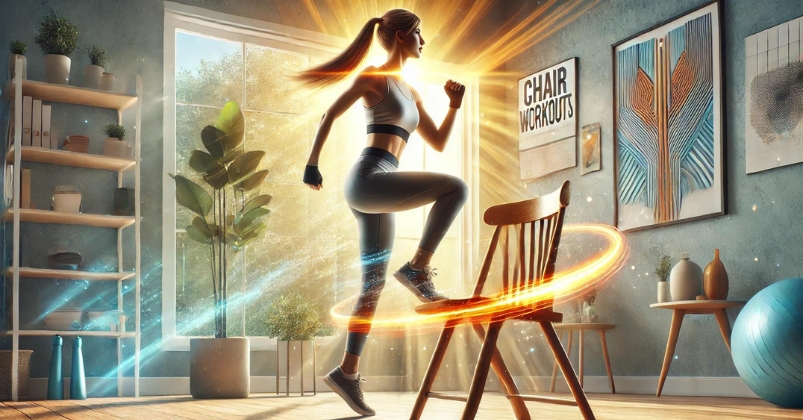
At the heart of every weight loss journey is the beautiful interplay of various factors, creating a harmonious symphony that determines the success of one's efforts. Chair exercises, often underestimated, play a significant note in this melody. Here’s why:
- Understanding Metabolism: The body's metabolism is akin to a furnace that burns calories. Every movement we make, be it a blink, a step, or a stretch, burns energy. Chair exercises, though seemingly understated, stoke this furnace. Each lift, twist, and bend, while seated, translates into calories burnt, actively supporting weight loss goals.
- The Magic of Muscle Activation: The act of engaging multiple muscle groups even while seated means that your body is continuously working. This muscle activation not only tones the body but also increases resting metabolic rate. The more muscle you engage and build, the more calories you burn, even when you're not exercising.
- Accessibility and Consistency: The beauty of chair exercises lies in their inherent accessibility. Whether you're at home, in the office, or traveling, a chair is almost always within reach. This ease of access drastically improves the chances of maintaining a consistent workout routine. And as any fitness expert will attest, consistency is often the secret ingredient to sustainable weight loss.
- Adaptable Intensity: One size doesn’t fit all, especially in the world of fitness. Chair exercises are versatile, catering to different fitness levels. Whether you're a beginner looking for a gentle introduction to exercise or an experienced fitness enthusiast seeking to add variety to your routine, chair workouts can be modified to match and challenge your intensity levels, ensuring everyone gets an effective workout tailored to their needs.
In this weight loss symphony, chair exercises play a melody of simplicity, efficiency, and adaptability.
They debunk the myth that only high-impact, strenuous workouts yield results, paving the way for a more inclusive and accessible approach to fitness.
Heart Rate and its Importance
Getting the Heart Pumping: The Role of Cardio in Chair Exercises
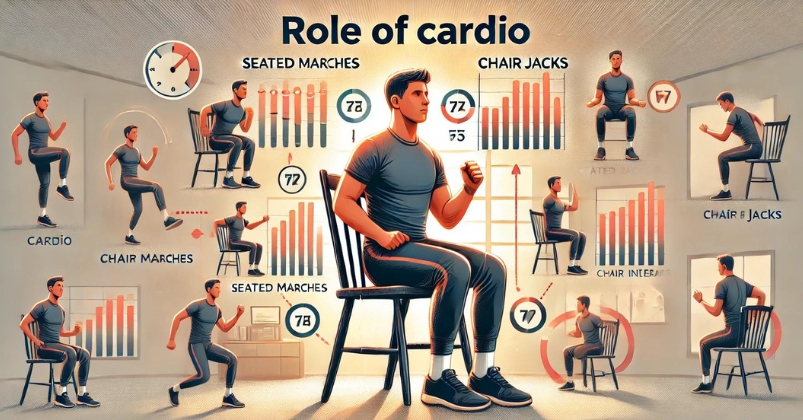
When we think of cardiovascular workouts, the mind often conjures images of runners pacing through trails or athletes drenched in sweat after a high-intensity interval training session.
However, the essence of cardio lies not in the intensity but in its ability to elevate the heart rate, enhancing blood circulation and promoting better respiratory function.
Chair exercises, with their unique blend of simplicity and effectiveness, bring cardiovascular benefits right into the comfort of your living space.
- Seated Marches: This exercise is more than just lifting your legs alternatively. When done with vigor, seated marches can elevate your heart rate, mimicking the effect of a brisk walk. By engaging the core and pumping the arms simultaneously, you amplify its cardiovascular benefits, turning a simple march into a full-body workout.
- Chair Jacks: Inspired by the classic jumping jack, chair jacks offer a cardio boost without the jarring impact on the joints. While seated, simultaneously open your legs out to the sides and raise your arms, then return to the starting position. The fluid, repetitive movement gets the blood pumping, proving that you don't need to jump to reap the benefits of this iconic exercise.
- Engaging the Core Throughout: The heart isn't the only muscle getting a workout here. By consciously engaging the core during these exercises, you're ensuring better posture, added stability, and an extra layer of muscle activation. An engaged core transforms seemingly simple movements into compound exercises, ensuring maximum benefits with every motion.
- Tempo and Intervals: To further enhance the cardiovascular aspect of chair workouts, play with the tempo. Incorporate short bursts of rapid movements followed by brief rest periods. This interval approach not only keeps the workout engaging but also ensures that the heart rate stays elevated, maximizing calorie burn.
In the world of chair exercises, cardio takes on a new meaning. It breaks free from the bounds of running tracks and gym floors, showing that with the right approach, even the confines of a chair can become a playground for heart-healthy workouts.
Whether you're looking to improve heart health, boost stamina, or shed some pounds, chair-based cardio exercises are your trusty companions on this journey.
Creating a Daily Routine
Consistency is key. Incorporate a mix of the following chair exercises to create a daily routine:
- Lower Body Workouts: Target your thighs, glutes, and calves.
- Leg Raises: Helps in toning the thigh muscles.
- Low-Impact Exercises: Ideal for beginners or those with joint pain.
- Resistance Bands: Add resistance to your chair workouts to enhance muscle toning.
- Entire Body Workouts: Engage multiple muscle groups for a comprehensive workout.
- Abdominal Muscle Training: Tone and strengthen your core.
Lower Body Chair Exercises
Chiseling the Lower Body: Effective Leg and Glute Workouts from a Chair
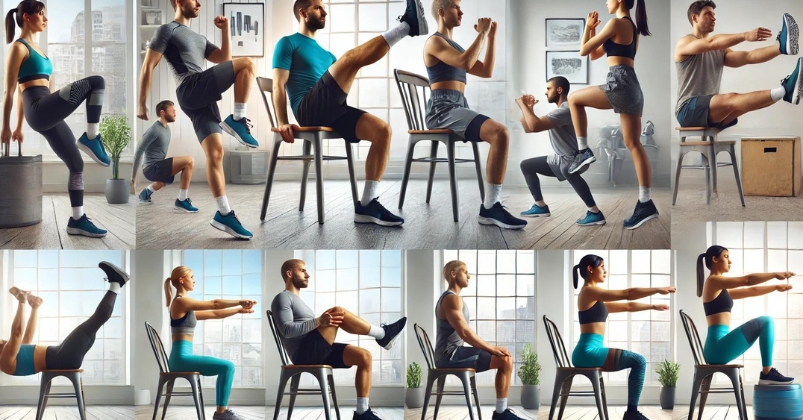
The foundation of our body, our legs and glutes, are powerhouses of strength and endurance. They carry us through our daily adventures, support our posture, and play a pivotal role in various functional movements.
However, these muscles often bear the brunt of sedentary lifestyles. The good news? Chair exercises offer an innovative solution to target, tone, and strengthen these crucial muscle groups, all while seated.
- Seated Leg Lifts: At first glance, lifting your leg from a seated position might seem simplistic. However, this movement, when executed with precision, targets the quadriceps—the large muscle group at the front of your thigh. To elevate its intensity, add ankle weights or resistance bands. But even without them, maintaining a controlled, slow lift followed by a deliberate descent ensures that your muscles are engaged throughout, promoting strength and endurance.
- Chair Squats: One of the foundational movements in fitness, the squat is a compound exercise that targets multiple muscle groups at once. The chair variation provides a guideline on depth and ensures safety, especially for beginners. Standing in front of the chair, engage your core as you push your hips back, bending your knees and lowering down as if to sit. Just before touching the seat, push through your heels, engaging your glutes and hamstrings, and return to a standing position. Not only does this movement strengthen the entire lower body, but it also promotes functional fitness, aiding in everyday activities.
- Knee Extensions: While seated with a straight back, extend one leg outward, keeping it parallel to the ground, and then slowly bring it back down. This movement, although appearing gentle, fires up the quadriceps and, when done repetitively, can aid in sculpting and toning the thighs.
- Seated Leg Circles: This move is a favorite among Pilates enthusiasts. Lifting one leg, trace small circles in the air, engaging not just the moving leg's muscles but also the stabilizing leg's. Alternate between clockwise and counterclockwise movements. This exercise not only tones the thighs and calves but also enhances joint mobility and flexibility.
Incorporating these exercises into your routine can transform a mere chair into a powerful tool for lower body fitness.
As with all workouts, the key lies in maintaining proper form, consistent practice, and gradual progression in intensity.
So, the next time you're seated, remember that you have a mini fitness studio right under you, ready to chisel and strengthen your lower body.
Using Resistance Bands
Low-Impact Yet High Results: The Magic of Resistance Bands in Chair Workouts
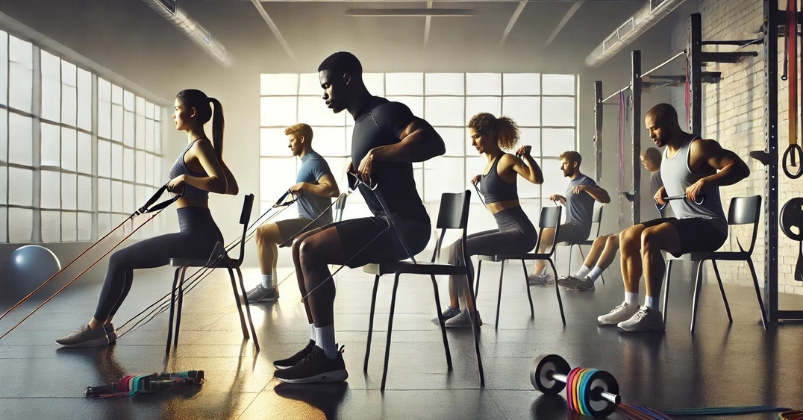
In the expansive toolkit of fitness equipment, resistance bands often emerge as unsung heroes.
These stretchy, versatile tools pack a punch well beyond their modest appearance. When combined with chair exercises, resistance bands provide a dynamic synergy, elevating the effectiveness of low-impact workouts while ensuring adaptability and progression.
- Understanding Resistance Bands: Before delving into the exercises, it's crucial to appreciate the unique benefits of resistance bands. Unlike weights, which rely on gravity to provide resistance, these bands offer resistance in multiple directions, engaging muscles more holistically. They're adaptable, portable, and available in varying resistance levels, catering to beginners and seasoned athletes alike.
- Seated Band Row: Sit on the edge of a chair, feet flat on the ground, and place a resistance band around your feet. Holding each end of the band, pull back, engaging the muscles of your back, especially the latissimus dorsi. This movement not only strengthens the back but also improves posture—a boon in an age of perpetual hunching over screens.
- Leg Presses with Band: In a seated position, loop the resistance band around one foot while holding the ends firmly with both hands at chest level. Push the foot forward against the resistance and then return to the starting position. This movement targets the quadriceps, ensuring toning and strengthening without any jarring impact.
- Bicep Curls: Holding the ends of the band in each hand, step on the middle of the band with both feet. Keeping elbows close to the body, curl your hands towards your shoulders, working the bicep muscles. The seated position ensures stability and focus on the muscle group being targeted.
- Band Assisted Leg Lifts: By looping a resistance band around both ankles and performing the previously mentioned seated leg lifts, you add an additional challenge to the hip flexor and quadricep muscles. The resistance band ensures that the muscle fibers are engaged throughout the lifting and lowering phase, amplifying the benefits of the exercise.
- Safety and Progression: As with all exercises, it's vital to ensure correct form when using resistance bands to prevent injury. Start with a band of appropriate resistance and progressively move to tighter bands as strength and endurance increase. The bands' elastic nature ensures consistent tension, making the muscles work harder throughout the exercise's entire range of motion.
Marrying the gentle nature of chair exercises with the adaptable resistance of bands creates a fitness routine that's both effective and kind to the joints. It's a testament to the fact that intensity in workouts doesn't necessarily translate to high impact. Sometimes, all it takes is a stretchy band and a chair to pave the path towards health and vitality
Engaging the Entire Body
Optimal fitness and effective calorie burn hinge on holistic exercises that engage the entire body.
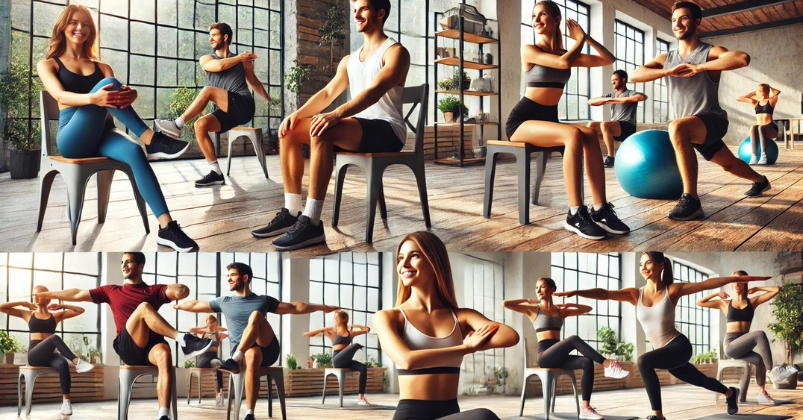
While isolated exercises have their place in targeted muscle building and rehabilitation, full-body movements activate multiple muscle groups, boost metabolism, and offer a comprehensive workout in less time.
When performed on a chair, these exercises can be surprisingly challenging, providing both strength training and cardiovascular benefits.
- The Power of Compound Movements: Compound exercises are those that engage two or more joint movements, thereby working several muscle groups at once. When executed on a chair, these movements can be adjusted for all fitness levels, ensuring safety while maximizing engagement.
- Seated Jacks: Mimicking the motion of jumping jacks but in a seated position, seated jacks are an excellent cardio workout. Start by sitting on the edge of the chair. Extend your legs out and open your arms wide, then swiftly bring your legs together and clap your hands in front of you. This rapid movement gets the heart rate up and involves both the upper and lower body.
- Chair Planks: Place your hands on the seat of a sturdy chair while extending your legs back into a plank position. This exercise engages the core, shoulders, arms, and legs, making it a full-body workout. To intensify, add leg lifts or knee tucks.
- Seated Torso Twists: Holding a weighted object (or even just clasping your hands together), sit on the edge of the chair. Keeping your spine straight, rotate your torso to the left and then to the right. This motion engages the obliques, deltoids, and back muscles, providing a comprehensive core workout.
- Seated Knee Lifts with Rotation: Sit tall and bring one knee towards your chest while simultaneously rotating your torso to bring the opposite elbow towards the lifted knee. Alternate sides. This engages the abdominals, obliques, hip flexors, and shoulders, providing a cardio boost as well.
- Emphasizing Flexibility and Balance: While strength and cardio are vital, full-body chair exercises also pave the way for improved flexibility and balance. Incorporate movements that stretch various parts of the body and challenge stability to ensure a well-rounded fitness regimen.
Incorporating whole-body movements in chair workouts amplifies calorie burn, enhances coordination, and ensures a balanced fitness approach. By actively involving the entire body, we not only optimize our workouts but also integrate functional fitness elements, ensuring that our training translates to ease and efficiency in everyday activities.
Strengthening Abdominal Muscles
The core, often referred to as the body's powerhouse, is the central link connecting our upper and lower body.
Its strength determines our posture, balance, and the ability to perform everyday activities with ease.
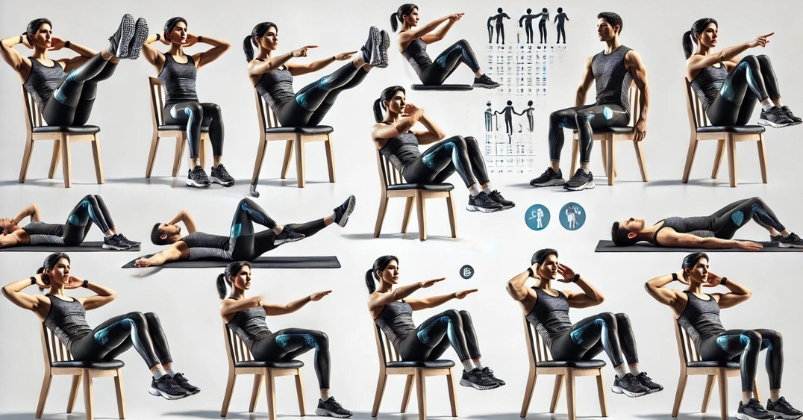
Strengthening the Core: Beyond Traditional Sit-Ups
While many associate core workouts with the often-dreaded sit-ups, chair exercises present a myriad of innovative ways to target this crucial muscle group without ever hitting the floor.
- The Core's Vital Role: Before diving into exercises, it's essential to recognize the importance of a strong core. It's not just about the visible ‘six-pack'. The core comprises various muscles, including the rectus abdominis, obliques, and the deep-set transverse abdominis, all of which collaborate to support the spine, protect internal organs, and ensure movement efficiency.
- Seated Bicycle Crunches: While sitting on the edge of a chair, place your hands behind your head with elbows out wide. Lift your right knee towards your chest while twisting your left elbow to meet it. Alternate sides in a pedaling motion. This exercise targets the obliques, rectus abdominis, and hip flexors.
- Chair Leg Raises: Sit firmly against the chair's backrest. Keeping your legs straight, slowly lift them to hip height, and then lower them without letting them touch the ground. This exercise intensely engages the lower abdominals.
- Seated Russian Twists: Holding a weighted object or clasping your hands together, sit slightly back with a straight spine, lifting your feet off the ground. Rotate your torso to the left, bringing the weight or hands towards the chair's left side, then twist to the right. This dynamic movement fires up the obliques and rectus abdominis while challenging your balance.
- Isometric Chair Crunch: Sit up straight and place both hands on your thighs. Press down on your thighs while trying to contract your abdominal muscles, as if you're trying to pull your belly button towards your spine. Hold for several breaths, then release. The beauty of this exercise lies in its subtlety; it can be done almost anywhere, making it perfect for those moments when you need a discreet workout.
- Pilates-Inspired Chair Scoop: Sit at the edge of the chair with feet hip-width apart. Place your hands behind your thighs. With a straight spine, begin to curl backward, as if you're scooping out your belly, creating a C-curve with your spine. Hold the scoop, then slowly return to the starting position. This move channels the essence of Pilates, emphasizing control and deep core engagement.
The advantage of chair-based core exercises lies in their accessibility and versatility. They allow for targeted strengthening without the need for elaborate equipment or ample space.
By diversifying our approach to core training, we not only build resilience and power in this essential muscle group but also enrich our fitness journey with variety and innovation.
Embracing Chair Workouts for a Healthier You
Incorporating chair exercises into your routine can be both fun and effective. It's all about how you approach it and ensuring you stay consistent.
Whether you're limited by space, physical constraints, or simply enjoy the comfort of home workouts, chair exercises provide a versatile solution. Remember, every bit of movement counts towards your fitness journey.
Stay motivated, and soon you'll see the results of your commitment and hard work.
FAQs
Yes, combined with a balanced diet and consistency, chair exercises can aid weight loss.
Ideally, aim for at least 30 minutes, 5 days a week.
While they are low-impact, consistent chair exercises can still provide cardiovascular benefits.
No, but they can enhance muscle toning and strength.
Any sturdy chair without wheels. Avoid chairs with armrests for more freedom of movement.
Yes, 5-10 minutes of light stretching or marching in place is advised.
Wearable fitness trackers or manually checking your pulse are effective methods.
Absolutely. In fact, chair exercises are often recommended for the elderly due to their low-impact nature.
Wear comfortable shoes with a good grip. Athletic shoes are ideal.

